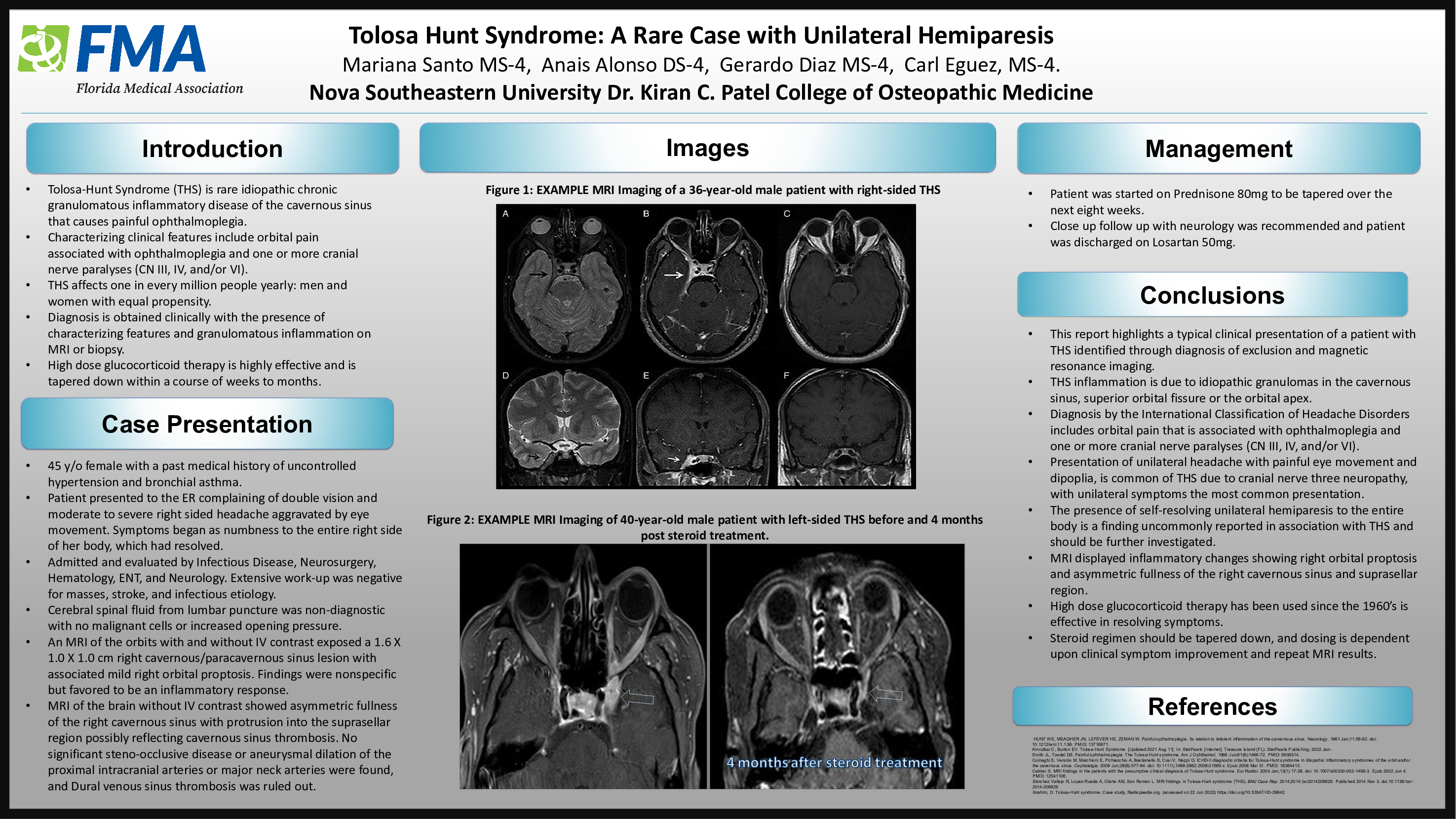Abstract
Tolosa-Hunt Syndrome (THS) is an inflammatory disease of the cavernous sinus that causes painful ophthalmoplegia. Characterizing clinical features include orbital pain associated with ophthalmoplegia and one or more cranial nerve paralyses (CN III, IV, and/or VI). THS affects one in every million people yearly: men and women with equal propensity. Diagnosis is obtained clinically with the presence of characterizing features and granulomatous inflammation on MRI or biopsy. High-dose glucocorticoid therapy is highly effective and is tapered down within a course of weeks to months. Case Presentation: We present a case of a 45 y/o female with a past medical history of uncontrolled hypertension and bronchial asthma. The patient presented to the ER complaining of double vision and moderate to severe right-sided headache aggravated by eye movement. Symptoms began as numbness to the entire right side of her body, which had resolved. The patient was admitted and evaluated by Infectious Disease, Neurosurgery, Hematology, ENT, and Neurology. Extensive work-up was negative for masses, stroke, and infectious etiology. Cerebral spinal fluid from lumbar puncture was non-diagnostic with no malignant cells or increased opening pressure. An MRI of the orbits with and without IV contrast exposed a 1.6 X 1.0 X 1.0 cm right cavernous/paracavernous sinus lesion with associated mild right orbital proptosis. Findings were nonspecific but favored to be inflammatory. MRI of the brain without IV contrast showed asymmetric fullness of the right cavernous sinus with protrusion into the suprasellar region possibly reflecting cavernous sinus thrombosis. No significant steno-occlusive disease or aneurysmal dilation of the proximal intracranial arteries or major neck arteries were found, and dural venous sinus thrombosis was ruled out. The patient was diagnosed per Neurology with THS. The patient was started on prednisone 80mg to be tapered over the next eight weeks. Close follow-up with neurology was recommended, and the patient was discharged on Losartan 50mg. Discussion: Tolosa-Hunt Syndrome is a rare idiopathic inflammation of the cavernous sinus that causes painful ophthalmoplegia. Diagnosis by the International Classification of Headache Disorders includes orbital pain that is associated with ophthalmoplegia, and one or more cranial nerve paralyzes (CN III, IV, and/or VI). The patient presented with unilateral headache with painful eye movement and diplopia, a common symptom of THS due to cranial nerve three neuropathy. Unilateral symptoms are the most common presentation, and bilateral orbital involvement is rare. The presence of self-resolving unilateral hemiparesis in the entire body is a finding not commonly reported in association with THS and should be further investigated. MRI displayed inflammatory changes showing right orbital proptosis and asymmetric fullness of the right cavernous sinus and suprasellar region. THS inflammation is due to idiopathic granulomas in the cavernous sinus, superior orbital fissure, or the orbital apex. High-dose glucocorticoid therapy has been used since the 1960s is effective in resolving symptoms. The steroid regimen should be tapered down, and dosing depends upon clinical symptom improvement and repeat MRI results. This report highlights a typical clinical presentation of a patient with THS identified through a diagnosis of exclusion and magnetic resonance imaging.






